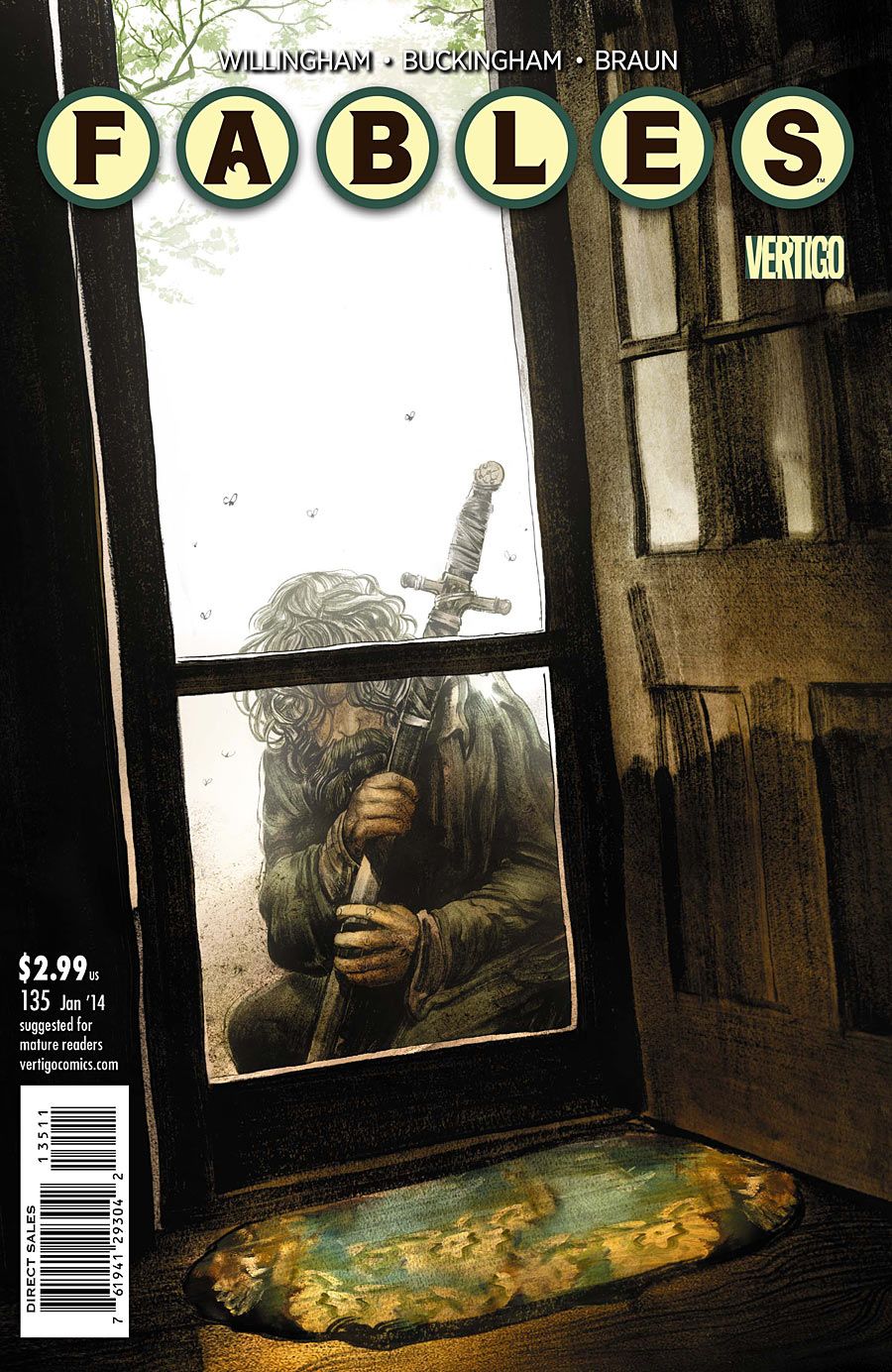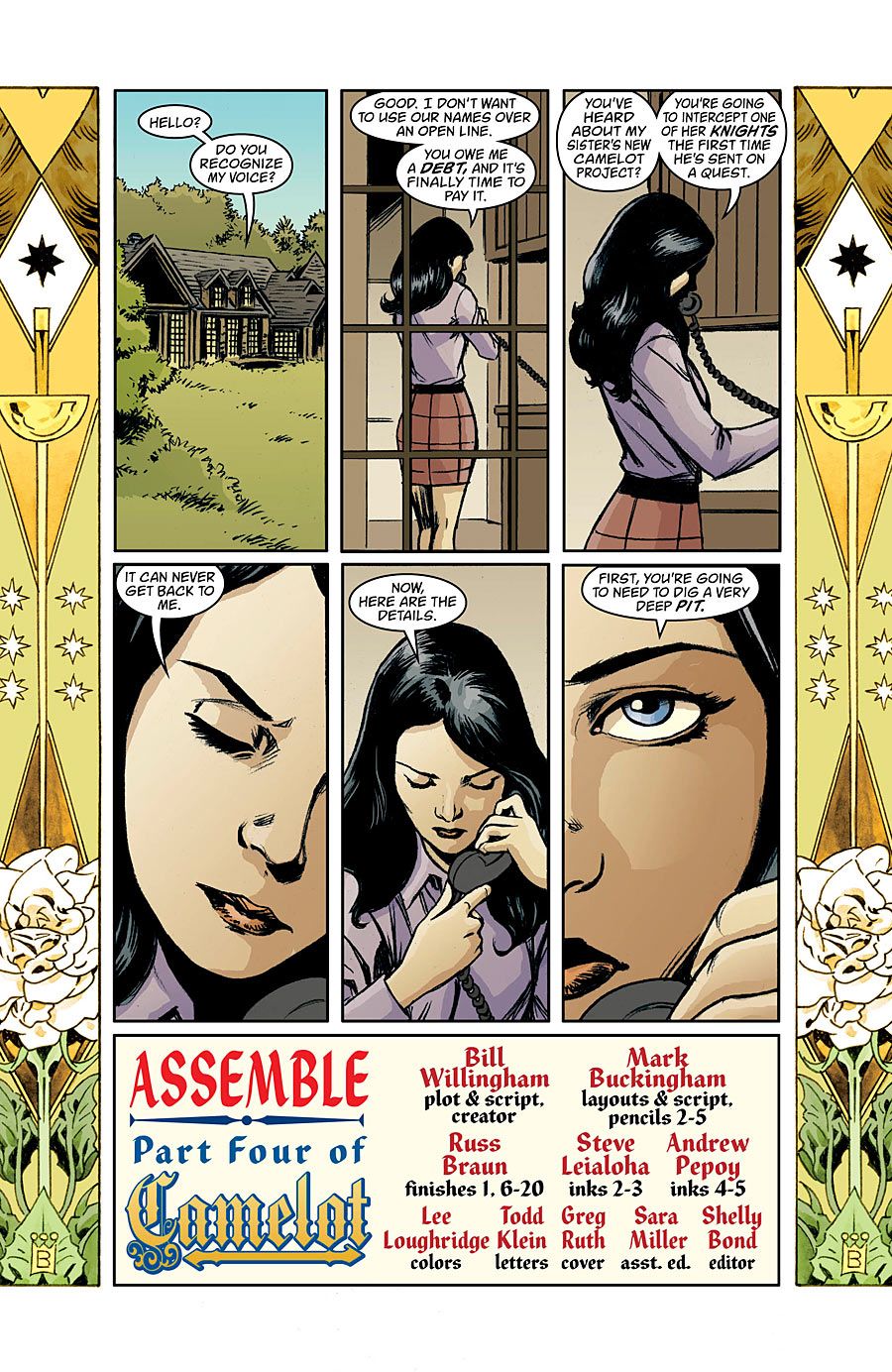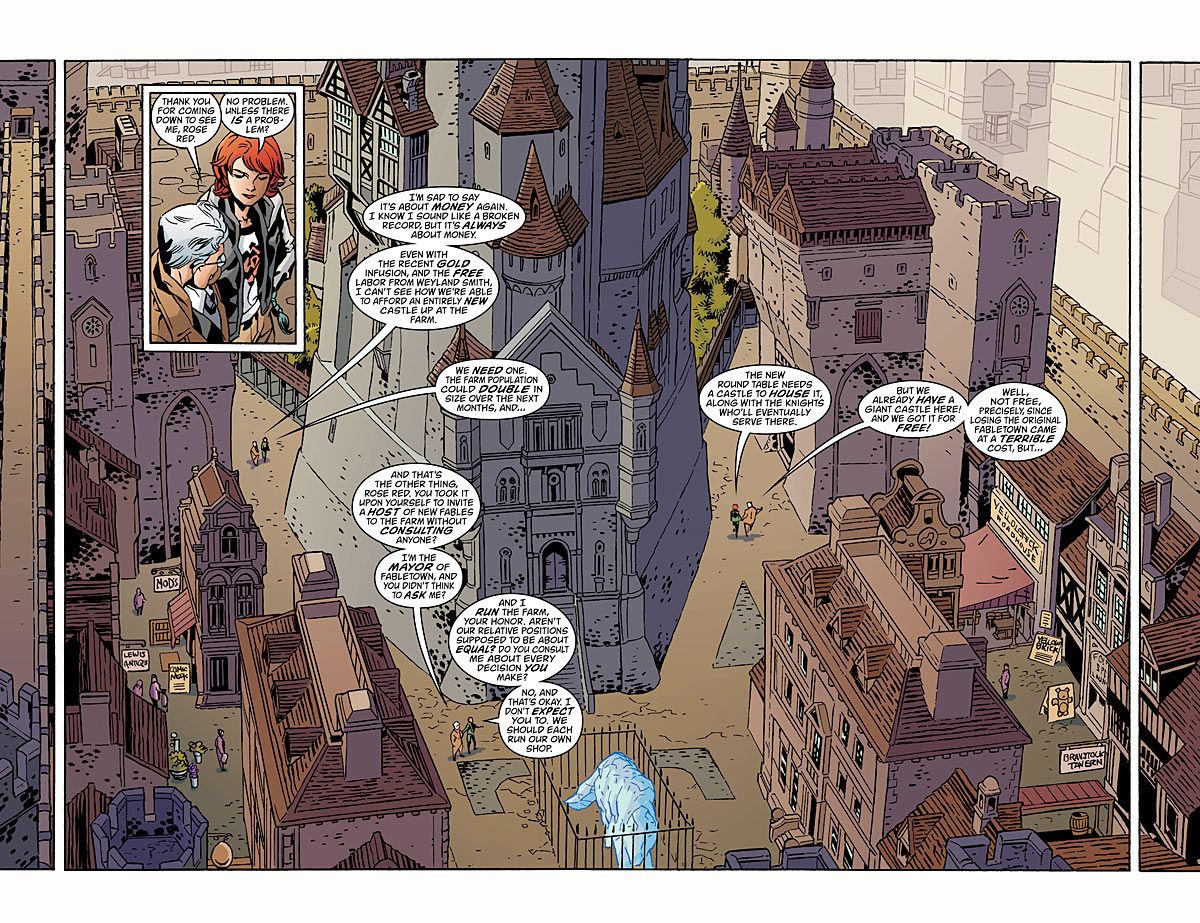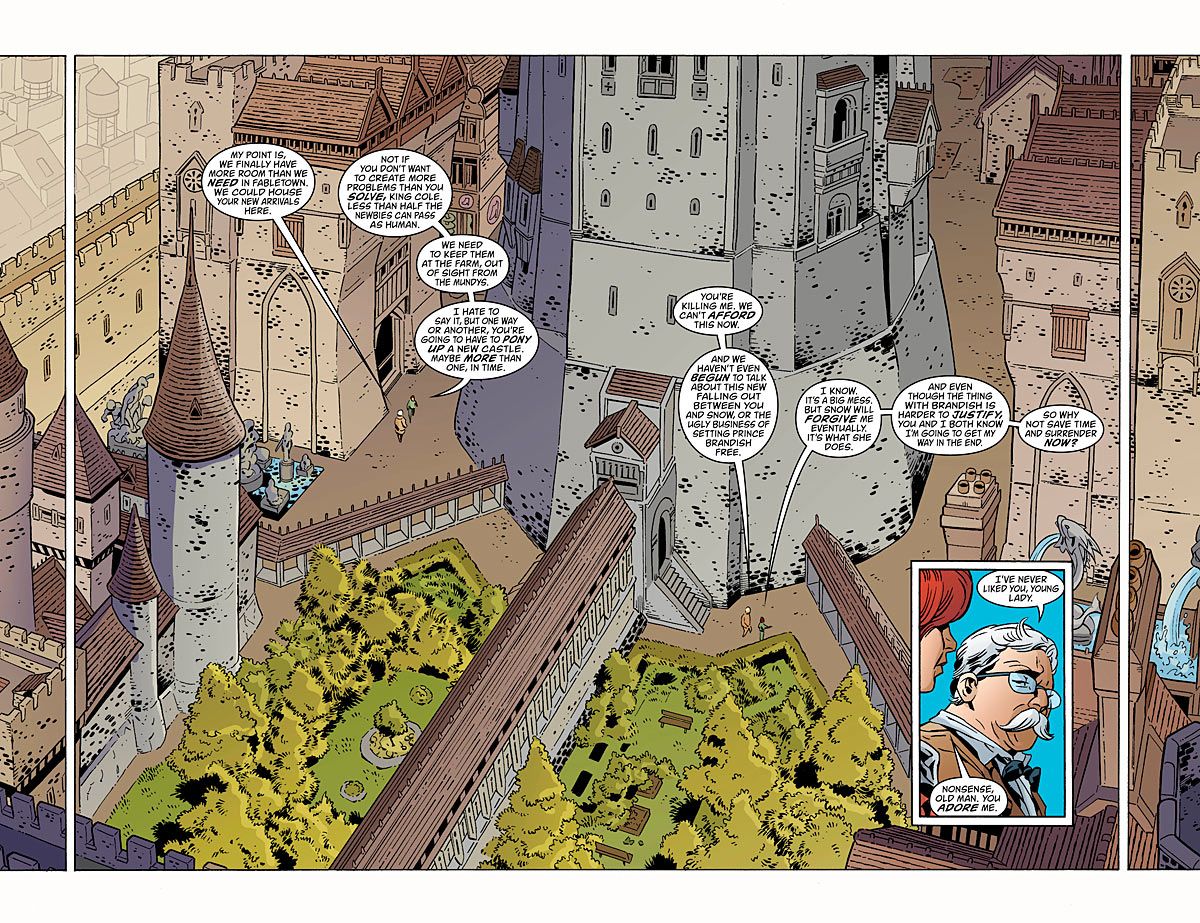Bill Willingham shocked the industry in early November when he announced the end of his long-running Vertigo Comics series, "Fables." But the multiple Eisner Award winner would never bow out quietly; it's not his way.
The New York Times best-selling writer and famed British artist Mark Buckingham will close the hit series with a 10-part, yet-to-be-named epic arc, which will run through the final (and oversized) issue, "Fables" #150.
If that's not enough for you, Willingham has also written an original graphic novel called "Fairest in All the Land," which Vertigo released this week. Continuity-wise, the story, which predominantly features Cinderella, one of the stars of the ongoing spinoff series, "Fairest," sits neatly between "Camelot," the arc currently underway in "Fables" and the previously mentioned, yet-to-be-named final arc.
Wishing to remain spoiler-free, Willingham shared a few choice details about his leading lady (Cinderella), the narrator of "Fairest in All the Land" (the Magic Mirror) and how a murder mystery originally conceived as only part of the story evolved into the basis of the entire plot.
Willingham also talked to CBR News about the end of "Fables," teased which classic characters would be featured in the final arc (all of them) and why it was time to say goodbye.
CBR News: Did you wake up one morning and say, "Today's the day," or had you been mulling bringing "Fables" to an end for some time?
Bill Willingham talks about the new "Fairest in All the Land" OGN and his plans for "Fables'" final stretch
Bill Willingham: It's been mulled for a while in the sense that I always have in the back of my head: "If you get the word right now that you're dying in a month, how do you end it?" There's always that fictional doctor waiting just off stage to say, "You've contracted this rare disease of which there has only been five instances in history and luckily, we have pinned down exactly how many days you have left." That's always been in the back of my head.
Willingham Announces "Fables" to End with Issue #150
But the decision to end "Fables" when it will be ended now came mostly as a result of planning this latest, which is now going to be the last, big arc leading up to "Fables" #150. It became a bigger and more dramatic thing to the point where it was just obvious: "Oh, I see now this is the final story. No wonder it's so big and important."
Is the ending going to be what you always imagined it to be or did it sneak up on you a bit?
A little bit of both. It contains some of the elements of which I knew, all along, had to go into the ending. There have been a couple of times over the course of "Fables" where I said, "This can be the ending point." For example, "Fables" #75 when Geppetto signs the Fabletown Compact. That was just an obvious moment. But there is always that pesky little voice that says: "That's great. What happens next?"
And it's great that I'm inflicted with that because it's hard to be in this business and not have a healthy dose of that pushing you. But this time, it was pretty clear that it was it. Did I answer your question? [Laughs]
Yes, you did. Your current arc, "Camelot," comes to a close in January. Do we head right into the final arc after that?
"Camelot" plants the seeds for the final arc. Between "Camelot" and the yet unnamed big final arc, which I hope will not be named "The Big Final Arc," is a one-issue Geppetto story and then a two-issue story drawn by Steve Leialoha story called "The Boys in the Band," which takes care of the other shoe that has to drop to set up the big final arc.
Those three issues take place after "Camelot" and then starting with "Fables" #141, we basically count down to #150, which is going to be an oversized, wrap-everything up issue along with some additional short stories from various artists in addition to the main story arc with all of the main characters. We're going to try and pick off as many of the supporting cast as possible and tell stories about what is the ultimate fate of each and every character as we say goodbye.
A few years ago at Comic-Con, you released a one-page tale featuring Ambrose Wolf and Ozma that you said hinted at what the second hundred issues of "Fables" would be all about. Will the fates of all of Snow and Bigby's children be revealed in this final arc?
Yes, the prophecy about the destiny of the cubs figures very much into the big final story. As a matter of fact, just before you called, I wrote a scene that pins down another one of those. We found out about which cubs fit into certain categories but there are still a couple of left to be revealed. But yes, all of their roles told in that particular piece of enigmatic, cryptic nonsense will be revealed.
I love "Fables," but we were actually scheduled to speak about "Fairest in All the Land" today -- which we will get to -- but first one more question. In addition to the new original graphic novel, over the years you've also released two spinoff ongoing series, several miniseries, graphic novels and a prose novel. Does the end of "Fables" also mean the end to these types of projects or will there be more "Fables" projects beyond "Fables" #150?
I am certain to the core of my being that [Vertigo executive editor] Shelly Bond already has all of those planned. [Laughs] When we ended "Jack of Fables," we killed everyone off because we both wanted that big everyone dies Shakespeare ending. And I promised that I wouldn't do that with "Fables." The way this ends is not that kind of an ending so the door is open after a reasonable time to take a break from the characters and subconsciously muddling through what would have been nice to do.
I think every writer in the world always thinks, "Oh, I should have done this instead..." Am I leaving the door open, at least a crack, to revisit them some day? Sure. There's a possibility. Not a guarantee but a possibility.
"Fairest in All the Land" is a big, bold project featuring a Wonderland of Artists -- your words. How did it come about and how did you land on the format of bookending the story with prose and telling it through a series of short stories featuring art by twenty-something artists?
"The Wonderland of Artists," I think, is a good way to mention them when you have more than a dozen artists. Listing all of them on a cover is a little problematic even from a tactical, layout point-of-view. The way to try and at least soften the blow, so you are not always going to be listed entirely, is to at least have the credit include the implied thank-you or appreciation that the artists are terrific -- mindbogglingly terrific. Using a lot of artists was always a part of the plans for "Fairest in All the Land." In its initial conception, it was going to mirror the "1001 Nights of Snowfall" graphic novel that we did for "Fables." Many stories are told and the combining element is that Snow White in the Scheherazade role is telling them. We were going to do pretty much the same with "Fairest in All the Land" where many stories are told about different characters and the combining element will be the Magic Mirror is the one telling the stories.
And this is what we did. And the different stories would be illustrated by different artists. However, as I was writing it, one of the bigger stories was going to be a murder mystery because I like murder mysteries, and it's probably fortuitous that because I like that, the setup for the most part -- I had little notes jotted down in there -- I set out to write that one first. And it grew. Because if I did murder mystery, I wanted to do a fair play murder mystery, which is the type where the average reader has about as much a chance of figuring out the mystery as the protagonist does by the time she figures things out. And when you do that you have to structure things pretty well.
Willingham's "Fables" Under Development for Film
And in a world where magic works, you have to allow for all sorts of stuff that would not be clues in a normal mystery and then you have to structure how that works and give that to the readership too so they understand how those rules work and figure into their possibility of solving the story. Because of that, the murder mystery that was going to be a part of this book just grew and grew and grew and grew until it pushed all the other stories out.
The nice thing about it is that it still allowed for lots and lots of characters. Specific stories may have been pushed out but the sprawling cast of characters was all included because it was a big story that takes place all over Fabletown and beyond.
And that is how it turned from a bunch of unrelated short stories to one mega-story with a different artist drawing each different chapter. There were 31 chapters drawn by 23 different artists -- just a huge undertaking that turned out, and I hate to pat myself on the back but from the artistic standpoint at least, splendidly.
I thought the story was pretty good too. [Laughs] I don't want to talk too much about the players beyond Cinderella as I don't want to spoil the story but can you talk a little about your leading lady?
I am certain that part of putting her front and center had to do with her being such a fun character. I did get to write her a little bit in "Fairest" but I didn't really get to substantially write her the way many of our guest writers have like Chris Roberson has done with the "Cinderella" miniseries and Marc Andreyko is doing another one now for the next arc in "Fairest." All of these writers whom I adore got to play with her much more than I have so in one sense, it's to reclaim the character back long enough to say, "I get to write a big, important story with her, as well."
In the other sense, the idea of "Fairest" is to contemplate mostly on the female characters because once you decide that all of the fairy tales exist in the same world or in my case, have been pushed together into the same world, the thing that happens so often in fairy tales, is the suggestion that one particular woman is the "fairest in all the land." It's sort of like when I grew up and I was the best artist in my school. But when I went to a bigger high school, I was suddenly just one of the dozens of "Well, I was the best in my school." Suddenly, there is competition and I'm not the automatic belle of the ball anymore. I transferred that feeling into these characters. "I was the fairest in all the land but all of those lands have been taken over and now we're stuck here together. Who really is the fairest?"
In part, this story revolves around that. Someone has made a list of all of the pretty Fables and intends to knock 'em off one by one. You are almost restrained or even required if you are going to have a lot of girls dying to make the hero one of the fairest in all of the land so that leaves us Cinderella.
Carey & Willingham Explore "The Unwritten Fables"
Just where the story was set time-wise, it was at a time where all of the regular detective types in "Fables" were not available. Bigby is currently dead, turned into a glass statue and then shattered. The last time we saw Grimble, the last of the security guards, he was turned into a little bluebird and Beast is off living in another land right now. Cinderella says she is a detective not a spy. They're not the same thing but she's the closest thing the Fables have right now so it becomes her job.
I like that only because in all of her previous stories, she was recognizably the best at what she did. There was no better than her. There was a cocky swagger, which I like in a character. This was putting her in water that she was not familiar with where she couldn't be as cocky and I think her first statement about the entire story is: "You need a detective and I'm a lousy detective." And then we're off to the races from there.
And I love her acknowledgement right off the bat where she asks, and I'm paraphrasing, "Wait a second. Why aren't I on the list of the fairest of them all?"
Right. She's trying to figure out who has this list of all of the pretty girls they want to kill and how come she's not on it.
I didn't want to go to the party but I'm upset that I didn't get invited to the party.
I have to tell you something. That encapsulates my attitude completely. There are all sorts of things which I have no desire to attend or participate with but I'm a little irked when I don't make the list of invitees. I know that feeling well.
Another nice thing, which you've alluded to, is that this story is set right in step with what's currently going on in "Fables," which isn't always the case with these side projects.
It is. We made it as self-contained as we could because we don't want to make it a requirement that someone has read everything else before you get to this. Any given book should not require homework. We try to make it as accessible as possible. That said it does fit in pretty solidly with what's going on right now. I think, and don't hold me to this because I would have to check my chart, this falls right between the "Camelot" arc and the beginning of the big, final saga.
"Fairest in All the Land," by Bill Willingham and featuring art by Chris Sprouse, Phil Noto, Adam Hughes, Renae De Liz, Fiona Meng and a Wonderland of other Artists, is on sale now.






